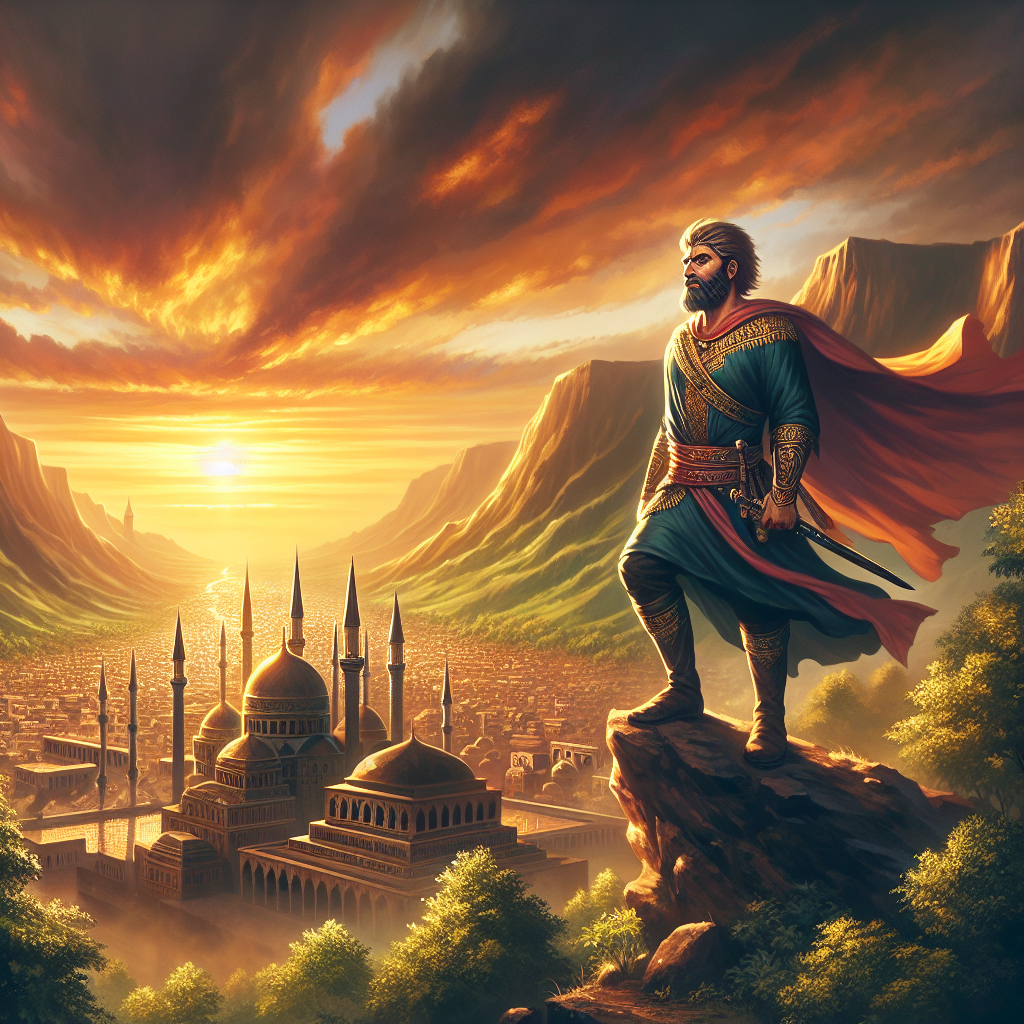
Crafting Grandeur Sultan Mehmed II’s Architectural Legacy
In the annals of history, Sultan Mehmed II stands as a towering figure, not only for his military conquests but also for his monumental contributions to architecture. His reign marked a transformative period in which the Ottoman Empire emerged as a dominant power, weaving its influence through the intricate tapestry of culture and architecture. This blog post explores Sultan Mehmed II’s architectural achievements, offering students a glimpse into a bygone era where stone and mortar became the language of empire.
Introduction to Sultan Mehmed II’s Architectural Vision
Sultan Mehmed II, often celebrated for his conquest of Constantinople in 1453, was much more than a military strategist—he was a visionary with an eye for architecture. His reign initiated a cultural renaissance that saw the transformation of Constantinople into Istanbul, the heart of the Ottoman Empire. Architecture became his tool to express power and identity, setting the stage for future generations.
Mehmed’s architectural endeavors were not merely about constructing buildings; they were about creating symbols of unity and strength. This post aims to unravel the architectural tapestry woven during Mehmed II’s reign, highlighting the significance of each structure in establishing Ottoman cultural dominance.
Rebuilding Constantinople The Birth of Istanbul
Sultan Mehmed II envisioned a rebirth for Constantinople, transforming it into the bustling Ottoman capital, Istanbul. Following its decline under Byzantine rule, the city’s restoration was a priority. Mehmed embarked on a mission to rebuild, focusing on both grandeur and function.
The transformation was strategic and symbolic. By making Istanbul a center of Islamic architecture, Mehmed reinforced his empire’s cultural and religious identity. The city flourished under his patronage, becoming a beacon of architectural innovation and Ottoman might. This metamorphosis not only showcased his commitment to restoring the city’s former glory but also cemented his legacy as a patron of the arts.
The Fatih Mosque Complex A Jewel in Mehmed’s Crown
Among Mehmed II’s most significant architectural feats is the Fatih Mosque, a testament to his ambition and vision. Constructed between 1463 and 1470, the mosque emerged shortly after the conquest of Constantinople, symbolizing the transition of power.
The design of the Fatih Mosque is a blend of Byzantine and Islamic architectural styles, reflecting the cultural synthesis that characterized Mehmed’s reign. The surrounding külliye included schools, kitchens, a hospital, and a market, illustrating Mehmed’s vision of community-centered architecture. This complex not only served religious purposes but also acted as a hub for social and educational activities, cementing its role in daily life.
Topkapi Palace The Heart of Ottoman Power
Topkapi Palace, constructed under Mehmed II, served as the primary residence of Ottoman sultans and the empire’s administrative center. Its sprawling layout, adorned with gardens, courtyards, and pavilions, encapsulates the grandeur and authority of the Ottoman court.
Topkapi was more than a residence; it was a political statement. The palace’s architecture reflected imperial power and was designed to impress foreign dignitaries. It stood as a testament to Ottoman wealth and craftsmanship, with each element meticulously crafted to convey the empire’s might. The palace’s role extended beyond governance, serving as a cultural landmark that influenced the arts and architecture for centuries.
Fortifications and Strategic Architecture Securing the Empire
Mehmed II understood the importance of fortifications in securing his empire. Strategic constructions like Rumeli Hisarı on the Bosporus Strait were pivotal in controlling trade and military routes.
Built in 1452, Rumeli Hisarı played a crucial role during the siege of Constantinople, enabling Mehmed to assert control over key waterways. Its construction signified a shift in power dynamics, showcasing the military foresight of Mehmed’s reign. Other structures, like Anadolu Hisarı, complemented these defenses, ensuring the protection of Ottoman territories.
Bazaars and Caravanserais A Boost to Trade and Economy
Trade was vital to the Ottoman Empire’s prosperity, and Mehmed II’s development of trade infrastructure was instrumental. The Grand Bazaar in Istanbul, one of the world’s largest and oldest covered markets, epitomizes this focus on commerce.
Caravanserais and commercial buildings facilitated trade across the empire and beyond. These structures were designed to blend functionality with aesthetic grandeur, enhancing the empire’s economic growth. Mehmed’s investment in such infrastructure underscored his understanding of trade as a pillar of empire-building, fostering connections that spanned continents.
Mosques and Religious Buildings Beyond Istanbul Expanding Influence
Mehmed II’s patronage extended far beyond Istanbul, with religious structures dotting the empire’s landscape. These mosques reinforced Ottoman control and Islamic identity in newly conquered lands.
Each mosque served as a center for religious, social, and educational life, embodying the empire’s cultural ethos. Notable examples include mosques in cities like Bursa and Edirne, which played pivotal roles in integrating diverse communities under Ottoman rule. Mehmed’s architectural initiatives in these regions reflected his commitment to unifying his empire through shared cultural and religious practices.
Mehmed II and the Hagia Sophia A Symbol of Transformation
The Hagia Sophia, a crowning jewel of Byzantine architecture, underwent a significant transformation under Mehmed II. Following the conquest of Constantinople, it was converted from a Christian cathedral into a mosque, symbolizing the dawn of Ottoman-Islamic rule.
Architectural modifications, such as the addition of minarets and Islamic calligraphy, reinforced its new identity. The Hagia Sophia became a powerful emblem of Mehmed’s reign, showcasing the Ottomans’ ability to adapt and redefine architectural heritage. Its transformation marked a pivotal moment in history, bridging cultural divides and creating a lasting symbol of power and unity.
Architectural Synthesis Blending Styles to Reflect Empire
Mehmed II’s architectural endeavors were marked by a unique synthesis of styles, merging Byzantine, Persian, and Islamic influences. This blend gave rise to a distinct Ottoman architectural identity.
The harmonious integration of diverse elements in his constructions illustrated Mehmed’s vision of a multicultural empire. By drawing from various traditions, Mehmed’s architecture reflected the empire’s rich tapestry of cultures. This synthesis not only enriched the architectural landscape but also fostered a sense of cohesion and inclusivity within the Ottoman realm.
Architects and Craftsmen under Mehmed II Masters of Design
The success of Mehmed II’s architectural projects hinged on the talents of architects and craftsmen. Figures like Sinan the Elder played pivotal roles in shaping Ottoman architecture.
These artisans, influenced by Byzantine and Italian traditions, brought diverse skills to Mehmed’s court. Their expertise was instrumental in executing grand designs, transforming visions into reality. The collaborative efforts of these craftsmen resulted in architectural marvels that stood as testaments to Mehmed’s legacy, influencing future generations of architects and leaving an indelible mark on history.
Legacy of Mehmed II’s Architectural Achievements A Lasting Impact
Mehmed II’s architectural legacy extends far beyond his reign, leaving an indelible mark on the Ottoman Empire’s cultural and architectural identity. His projects set the foundation for future rulers, notably inspiring the magnificent works of Suleiman the Magnificent.
Istanbul became a cultural and architectural hub, attracting scholars, artists, and travelers from around the world. The preservation of Mehmed’s buildings underscores their historical and cultural significance, serving as reminders of a time when architecture was a language of power and vision. His achievements continue to captivate and inspire, reflecting the enduring impact of his reign on modern Turkish history and culture.
Conclusion A Vision Realized in Stone
Sultan Mehmed II’s architectural contributions were not merely constructions; they were embodiments of his vision for an empire that transcended boundaries. His buildings stand as monuments to his foresight, blending diverse influences to create a unique architectural identity.
For students exploring the annals of history, Mehmed II’s architectural legacy offers valuable insights into the power of vision and innovation. His achievements remind us that architecture, like history, is a canvas painted with the aspirations and dreams of those who came before. As we reflect on his legacy, we are invited to explore further, uncovering the connections between past and present, and finding inspiration in the stones that still speak of empire.







